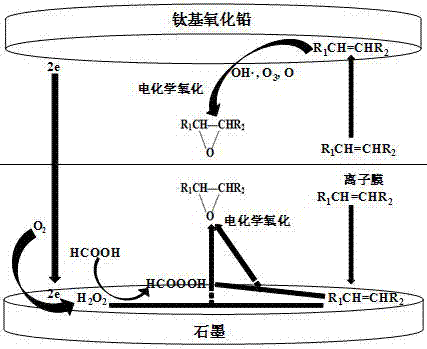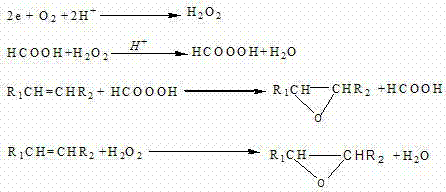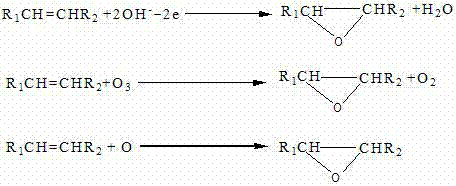Method for preparing epoxy caster oil in electrochemical oxidation way
An epoxidized castor oil, electrochemical technology, applied in the direction of fatty acid chemical modification, fatty acid production, etc., can solve the problems of low epoxide yield, large environmental pollution, high equipment requirements, easy control, low production investment, Equipment simple effect
- Summary
- Abstract
- Description
- Claims
- Application Information
AI Technical Summary
Problems solved by technology
Method used
Image
Examples
Embodiment 1
[0028] Add 40g of castor oil and 3ml of 0.1mol / L hydrochloric acid aqueous solution into the electrolytic cell, add 2g of formic acid into the cathode chamber and stir well. The anode uses a Pt electrode, and the cathode uses a stainless steel electrode. Put the air bubbler into the cathode chamber, connect to the power supply, and 3 / s rate oxygen. Connect the electrolytic cell to a DC stable power supply to ensure normal power supply, and adjust the current density to 0.2A / cm 2 . Set the reaction temperature to 20°C and the pH value to 6.5. After 3 hours of reaction, pour the liquid in the cathode chamber into a beaker, keep the layers static, and separate the liquid with a separatory funnel to obtain the oily epoxy castor oil. The epoxy content of epoxy castor oil is 0.145mol / 100g, and the epoxy oxidation rate is 80.3%.
Embodiment 2
[0030] Add 40g of castor oil and 6ml of 0.1mol / L hydrochloric acid aqueous solution into the electrolytic cell, add 5g of formic acid into the cathode chamber and stir well. The anode uses a titanium-based lead oxide electrode, and the cathode uses a graphite electrode. Put the air bubbler into the cathode chamber, connect to the power supply, and 3 / s rate oxygen. Connect the electrolytic cell to a DC stable power supply to ensure normal power supply, and adjust the current density to 0.5A / cm 2 . Set the reaction temperature to 40°C and the pH value to 4.5. After reacting for 5 hours, pour the cathode chamber liquid into a beaker, keep the layers static, and separate the liquid with a separatory funnel to obtain the oily epoxy castor oil. The epoxy content of epoxy castor oil is 0.168mol / 100g, and the epoxy oxidation rate is 93.3%.
Embodiment 3
[0032] Add 40g of castor oil and 4ml of 0.1mol / L hydrochloric acid aqueous solution into the electrolytic cell, add 4g of formic acid into the cathode chamber and stir well. A Pd electrode is used for the anode, and a Ni electrode is used for the cathode. Put the air bubbler into the cathode chamber, connect the power supply, and 3 / s rate oxygen. Connect the electrolytic cell to a DC stable power supply to ensure normal power supply, and adjust the current density to 0.4A / cm 2. Set the reaction temperature to 30°C and the pH value to 6.0. After 4 hours of reaction, pour the liquid in the cathode chamber into a beaker, keep the layers static, and separate the liquid with a separatory funnel to obtain the oily epoxy castor oil. The epoxy content of epoxy castor oil is 0.156mol / 100g, and the epoxy oxidation rate is 86.5%.
PUM
 Login to view more
Login to view more Abstract
Description
Claims
Application Information
 Login to view more
Login to view more - R&D Engineer
- R&D Manager
- IP Professional
- Industry Leading Data Capabilities
- Powerful AI technology
- Patent DNA Extraction
Browse by: Latest US Patents, China's latest patents, Technical Efficacy Thesaurus, Application Domain, Technology Topic.
© 2024 PatSnap. All rights reserved.Legal|Privacy policy|Modern Slavery Act Transparency Statement|Sitemap



